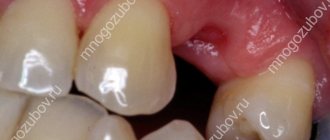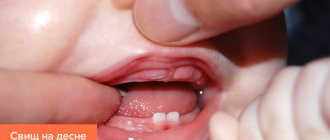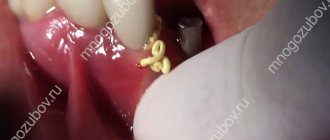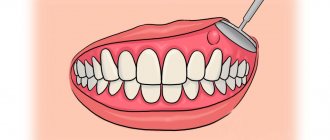WHY DOES PUS APPEAR IN THE Socket AFTER TOOTH EXTRACTION
This complication is a sign of infection of the socket, which, in turn, can occur for the following reasons:
- violation of the doctor’s recommendations for oral care (for example, removing a blood clot on your own);
- use of non-sterile instruments by the dentist;
- violation of tooth extraction technique;
- violation of the integrity of the walls of the maxillary sinus during removal;
- general decrease in immunity in the patient;
- the presence of a foreign body in the socket (for example, a fragment of a tooth or part of a cotton swab).
The risk of pus developing after the removal of a wisdom tooth is much higher than after the removal of any other tooth. This is due to the inaccessibility of the third molars, as well as additional difficulties during their extraction (for example, due to curvature of the coronal part or retention).
Gum suppuration is manifested by the following symptoms:
- pain;
- swelling and redness that do not go away, but on the contrary, intensify for three or more days;
- discharge from the socket;
- bad breath;
- general deterioration in health (fever, etc.).
Tooth abscess - symptoms and treatment
A tooth abscess does not go away without treatment. If you open it yourself, the pain may decrease significantly, but this does not eliminate the need for dental treatment. If the abscess is not drained, the infection can spread to the jaw tissue and other areas of the head and neck, which can lead to various complications.
Phlebitis and thrombophlebitis
When the veins are located close to the source of infection, a serious complication such as thrombophlebitis develops - inflammation of the vein with subsequent formation of a blood clot. First, the inflammatory process affects the walls of blood vessels (phlebitis), then spreads to the tissue surrounding the vein (periphlebitis) and finally covers the entire wall of the vein. Due to damage to the vessel, blood flow becomes slower, the composition of the blood changes, and clotting increases. All this contributes to the formation of a blood clot. In some cases, blood clots form in the venous sinuses of the brain.
Mediastinitis
Mediastinitis is an inflammation of the mediastinum (a complex of organs located in the chest cavity between the left and right mediastinal pleura, the posterior surface of the sternum and the thoracic spine and rib necks). Can be fatal.
The infection can penetrate into the mediastinum by contact, through the blood or lymph flow. The purulent exudate is so active that it can melt the intermuscular septa and walls of large arteries. In this regard, the infectious process spreads quickly and creates the risk of severe bleeding.
The source of the spread of infection leading to mediastinitis is usually inflammation in the area of the apex of the tooth root (sometimes in combination with infection of the tonsils or damage to the oral mucosa).
Acute or chronic sepsis
Sepsis is the most severe complication of a tooth abscess, which occurs when the immune system fails. The body cannot resist the infection, and it spreads throughout the body. Depending on the speed of onset of symptoms, sepsis can be fulminant (1-2 days), acute (5-7 days), subacute (1-2 weeks) and chronic. First of all, the functioning of the lungs is disrupted, and then other organs: liver, kidneys, etc. Subsequently, septic shock develops: blood circulation in the organ tissues slows down, and failure of several organ systems develops - multiple organ failure syndrome. When this syndrome occurs, most patients die within 2-3 days [8].
Meningeal diseases
Meningeal complications of a tooth abscess (meningitis, brain abscess, etc.) are not so common, but their mortality rate is quite high: it reaches 40-90%. Most often, these diseases arise due to the spread of infection from primary foci, the temporal region, pterygopalatine or infratemporal fossa.
SO WHAT TO DO IF PUS APPEARS AFTER TOOTH EXTRACTION?
The only correct solution in this situation is to contact a dentist. Before visiting the clinic, you can take painkillers, rinse or irrigate with herbal infusions, antiseptics or anti-inflammatory agents (this must be done carefully so as not to damage the clot, if it is still preserved). You should not delay visiting a medical facility for a long time, since the spread of infection can lead to osteomyelitis, abscess and other dangerous complications.
After diagnosis, doctors usually carry out:
- eliminating the cause of infection of the socket (for example, freeing it from bone fragments);
- cleansing from purulent masses;
- if necessary, suturing the wound;
- prescription of antibiotics and anti-inflammatory drugs.
To minimize the likelihood of complications, it is important to choose only reliable medical institutions for dental procedures. In addition, it is necessary to carefully follow the doctor's recommendations regarding oral care after the intervention.
Alveolitis after wisdom tooth removal: symptoms, treatment
Alveolitis after tooth extraction is a pathological process of inflammation of the socket, the so-called “dry socket syndrome”. As the disease develops, the alveolar bone is exposed and there is no protective blood clot. All this happens against the background of infection during tooth extraction and other factors. The pathology occurs in three to five percent of cases when roots are removed, brings a lot of discomfort, requires long-term and complex treatment, and is fraught with serious complications. The disease is not a death sentence, but it must be treated urgently under the supervision of an experienced dentist.
Alveolitis after tooth extraction - causes
The main factors for the occurrence of alveolitis:
- violation by the patient of the postoperative regimen;
- food debris getting into the wound area;
- poor-quality wound treatment, ingestion of foreign bodies;
- traumatic removal. Alveolitis is especially common after surgical removal of a wisdom tooth.
Factors provoking the development of alveolitis:
- smoking;
- caries;
- active rinsing, against the background of which the blood clot would simply be “rinsed out”;
- Negligent attitude to the dentist's recommendations.
Symptoms of alveolitis after wisdom tooth removal
The problem begins to appear on the second or third day after the operation. Main signs of pathology:
- severe, throbbing, aching pain;
- the absence of a formed blood clot or the presence of a “disintegrating” clot;
- increased pain that radiates to the temples, neck, ears;
- putrid odor from the mouth;
- increased body temperature;
- exposed bone tissue around the area of inflammation;
- the hole is covered with a coating of yellow, marsh, gray colors;
- discharge of purulent contents from the site of the extracted tooth is observed;
- general weakness, apathy;
- inflammation of the lymph nodes in the submandibular region;
- sleep disturbance due to aching pain;
- inability to eat and drink;
- fast fatiguability.
Alveolitis leads to intoxication of the entire body, and in this condition a person feels a loss of strength, loses working capacity, and due to the pain syndrome it is not possible to rest properly. In this case, professional dental treatment is a must!
How to determine alveolitis after wisdom tooth removal?
The disease can only be diagnosed by a dentist. You should not make diagnoses yourself; you need to contact an experienced doctor who will diagnose and prescribe the correct therapy.
How to properly treat alveolitis after tooth extraction?
Treatment of alveolitis after tooth extraction involves:
- surgical scraping of the hole (curettage), in which the dentist removes the necrotic clot;
- rinsing with antiseptic solutions;
- taking antibiotics, painkillers;
- performing physiotherapeutic procedures;
- treatment with an epithelializing composition, which will lead to rapid healing of the wound.
More radical methods are:
- placing turunda with iodine in the area of tooth extraction;
- formation of a secondary blood clot in the socket - the dentist injects anesthesia, scrapes out the bone walls, and forms a secondary wound. As a result, the hole is refilled with blood, a clot is formed, and the hole gradually heals;
In parallel with dental treatment, the patient is recommended to perform at home:
- infrequent rinsing of the mouth with antiseptic solutions;
- placing a special anesthetic and healing paste into the hole.
It is also necessary to avoid eating hard, hot and cold foods, brush your teeth with soft brushes, and do not use aggressive mouthwashes. It is better for the patient to stop smoking and drinking alcohol.
In general, treatment of alveolitis under the supervision of a dentist has a favorable prognosis. Full recovery can take up to 21 days, but the patient does not lose his ability to work. In the absence of adequate treatment, the problem can develop into osteomyelitis of the socket - a more serious illness.
Dentists at Zuub.rf specialize in the treatment of alveolitis after wisdom tooth removal. To get to a trusted doctor, sign up for a consultation. Professional help will help solve the problem and prevent complications.
If you have the symptoms described in this article, be sure to make an appointment at our clinic.
Don't self-medicate! Even the smallest problem, if not treated correctly, can significantly complicate your life.
By contacting us, you can be sure that:
- Get high-quality and free consultation .
- You will receive the best prices for treatment and the opportunity to receive a special promotional price.
- Only modern equipment and materials will be used.
- You will be treated by professional doctors with many years of experience.
- We offer treatment on credit or in installments. There is also the possibility of obtaining a tax deduction.
- We work seven days a week and without a lunch break, from 9 a.m. to 10 p.m.
+7 (495) 132-02-96
Make an appointment
Author of the article
Moroz Nazariy Lyubomirovich
- Specialization: Orthopedist, dental therapist, implant surgeon, periodontist
- Experience: 10 years
Was this article helpful?
Share the article with your friends!
From 9 to 22 and seven days a week
+7
Make an appointment
- Licenses and agreements
- About the clinic
- Privacy Policy
© 2021 Dental center 3uub: Dentistry Tsaritsyno, Biryulyovo, Baumanskaya, Basmanny, Belorusskaya, Central Administrative District, Southern Administrative District
Treatment in installments and tax deduction available
Pus in the gums - how to deal with suppuration
- home
- For patients
- Interesting
- Pus in the gums - how to deal with suppuration
- Pus in the gums - how to deal with suppuration
- Interesting
- home
For patients
An inflammatory process with suppuration is a fairly common problem when visiting a dentist. Symptoms of a progressive disease: painful sensations appear, bleeding when brushing teeth, the enamel may become darker, the gums are swollen and pus is released, discomfort and increased body temperature. Even with minor manifestations, you should not put off visiting a doctor so as not to put your health at risk.
Causes of pus in the gum of a tooth
Suppuration on the periodontium is formed as a result of infection penetration into the tooth or onto the surface of its root. Having gaps between teeth increases the chance of developing inflammation. Food gets into the spaces between the gums and teeth and, over time, becomes a problem. The main sources of the infectious process:
- trauma to the soft tissues of the oral cavity - the result of tooth extraction, poor-quality services for installing a crown, or even the use of a brush that is too hard,
- improper daily dental hygiene,
- exposure to chemicals on the gums,
- other infectious diseases.
If pus comes from the gums, this often indicates a serious disease: periodontal inflammation, periodontitis, periodontitis or gingivitis. Only a professional can make an accurate diagnosis, so home treatment for inflamed gums is unacceptable. Traditional methods can be used to relieve pain before visiting a doctor. For this, rinses or compresses with decoctions of chamomile, sage, oak bark, and St. John's wort are used.
Treatment of suppuration in the gums
First of all, dentistry takes an X-ray of the affected area, which will help determine the full picture of the disease. Depending on why the gums become inflamed and pus appears, the doctor prescribes the necessary treatment.
- Conservative methods. Mandatory therapy, which is carried out first. Cleaning of suppuration is carried out, regardless of the location: it can be a periodontal pocket or the opening of root canals with treatment of a diseased tooth.
- Surgical intervention. The dentist cuts the gum to remove the abscess, corrects the affected gum pocket or performs a resection - cutting off the tip of the tooth root. Pus under a wisdom tooth appears due to its improper growth - in this case, the molar is removed.
- Treatment with medications. To eliminate the infection, antibacterial, anti-inflammatory, and antiseptic agents are used. The doctor may prescribe oral medications, applications, or mouth rinses.
- Physiotherapy. Auxiliary treatment, which is aimed at effective drainage of purulent masses, regeneration of soft tissues, and removal of edema.
Preventive measures
Many cases of gum infection can be avoided by following daily hygiene recommendations. Don't forget to brush your teeth twice a day - pay attention to each tooth (at least 5-10 brush strokes). The spaces between your teeth should be cleaned with dental floss and mouthwash should be used after meals. Visiting the dentist twice a year will eliminate the possibility of developing pathologies and complications from dental diseases.
What to do if you see pus on the gum and redness? Even if you are not feeling unwell, you should see a doctor and get rid of the problem as quickly as possible. One of the components of successful treatment is the experience of dentists and high-quality equipment of the clinic. ROMDENT specialists will relieve you of all oral problems: you are always treated with a friendly attitude, painless therapy and modern methods of treating even advanced cases.











